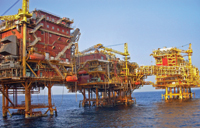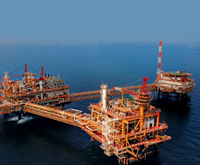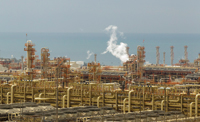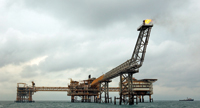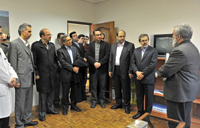
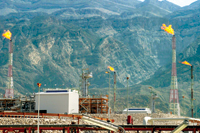 South Pars ... parts of the huge field still undeveloped
South Pars ... parts of the huge field still undeveloped
COMPLETION of the latest two development phases of Iran’s South Pars gas field has fallen two years behind schedule due to Western pressure on Tehran over its nuclear programme, which has been constrained participation in the country’s energy sector, the student ISNA news agency reports.
The agency says repeated withdrawals of foreign and Iranian contractors from the project due to international sanctions have contributed to the delay of the development of phases 15 and 16 of the giant offshore gas deposit.
The project, for which Tehran first awarded a contract in 2006, was abandoned by an international consortium led by Norway’s Aker Kvaerner. Two Iranian contractors, Khatam Al-Anbiya and Iranian Offshore Engineering and Construction Company, subsequently took it over under a $2.7 billion contract.
In 2010, however, those contractors pulled out after the UN Security Council approved a fourth round of sanctions on Iran that included an order to freeze the international assets of Khatam Al-Anbiya. The group is the construction wing of Iran’s Islamic Revolutionary Guards Corps. The new sanctions prevented it from accessing international financing for projects.
Development of phases 15 and 16 of South Pars, including the construction of gas-processing facilities, was originally scheduled for completion at the end of 2010. Some 26 months later than the anticipated in-service date, the project is still incomplete.
ISNA reiterats various projected dates for the commissioning of South Pars 15 and 16 that Iranian officials have announced at frequent intervals since November 2011.
In 2011, Iranian Oil Minister Rostam Ghasemi first said the project phases would start up in March 2012, but later amended this estimate to March 2013.
An unnamed South Pars field director was quoted as saying that technical personnel from South Pars phases 12, 22, 23 and 24 had been dispatched to help with the delayed phases 15 and 16.
“Given the magnitude of projects in the oil industry, the number of technical staff required for the pre-commissioning of these two phases [15 and 16] is insufficient and therefore we need to use workforces from other phases,” the director was quoted as saying.
Delayed construction and installation of two steel jackets needed to stabilise the drilling platforms for South Pars phases 15 and 16 have also put the projects behind schedule.
Drilling operations were halted last autumn due to rig repairs, ISNA says. Drilling and installation of wellheads will be finished by March 2014, the agency says.
The latest approved schedule for South Pars 15 and 16 called for drilling to be completed in mid-2012.
However, the construction of drilling platform decks by Iranian companies Iran Shipbuilding & Offshore Industries Complex Company, or Isoico, and Offshore Industries Company, or Saff, is still only 80-90 per cent complete, and won’t be finished before June 2013. Therefore, various parts of the project are headed for completion at different times, the agency says.
The two South Pars phases require, among other things, two platforms, 24 wells, two 32-inch seabed pipelines to move gas 100 km to shore, gas-sweetening facilities and utilities.
The finished project is expected to produce 50 million cubic metres per day of sales gas, 80,000 bpd of condensate, 400 mt/d of sulphur and other products such as LPG. It is set to generate billions of dollars of annual revenue for Iran’s government.
The cost of South Pars projects has roughly doubled in the years since the original development contracts were signed, adding to the difficulties domestic companies face in taking over such developments.
Iran hopes to use South Pars gas production, for which 28 phases have been planned, as the basis for ambitious plans for gas exports.
The vast offshore reservoir, shared with Qatar, which calls its side North Field, holds about 1,400 tcf of reserves in total of which about 500 tcf accrue to Iran. Those reserves account for roughly half Iran’s total gas reserves, which are the world’s second biggest.
Qatar has already extensively developed its North Field, which has enabled the Persian Gulf emirate to establish itself as the world’s leading LNG exporter with 77 million mt of annual production capacity.



















































































